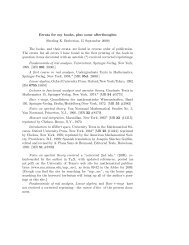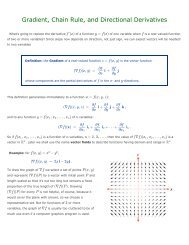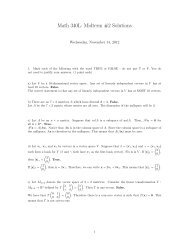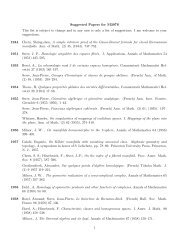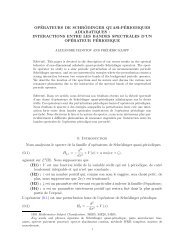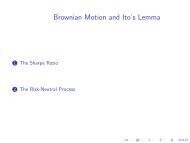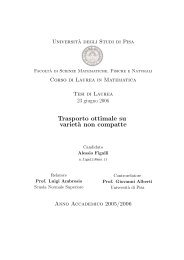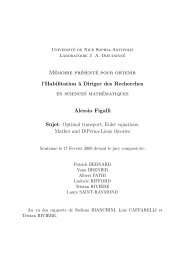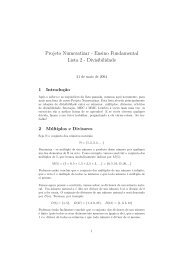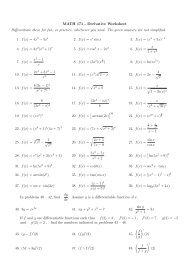Group-Theoretic Partial Matrix Multiplication - Department of ...
Group-Theoretic Partial Matrix Multiplication - Department of ...
Group-Theoretic Partial Matrix Multiplication - Department of ...
Create successful ePaper yourself
Turn your PDF publications into a flip-book with our unique Google optimized e-Paper software.
Figure 1: A visualization <strong>of</strong> the aliasing set in Example 2.10, where the input<br />
matrices are the left and middle rectangles, and the output is on the right. A<br />
triple ((i, j), (j ′ , k), (i ′ , k ′ )) corresponds to a pair <strong>of</strong> lines from (i, j) in the left<br />
factor matrix to (j ′ , k) in the right, and from (j ′ , k) in the right factor matrix<br />
to (i ′ , k ′ ) in the product; the set <strong>of</strong> all (i, j) which is the start <strong>of</strong> a line in the<br />
diagram is the left aliasing set.<br />
It is impossible to have only one <strong>of</strong> i = i ′ , j = j ′ , k = k ′ (if, for example,<br />
only i = i ′ held, then we would have s −1<br />
i euk = s −1<br />
i ′ uk). Thus, an incorrect term<br />
in the Cohn-Umans algorithm will only occur having at least two <strong>of</strong><br />
1. being in the wrong row given its first multiplicand,<br />
2. being in the wrong column given its second multiplicand, or<br />
3. having its multiplicands coming from different positions in their respective<br />
row and column.<br />
Definition 2.8. Let A be a set <strong>of</strong> aliasing triples for S, T, U ⊆ G. We say that<br />
I and J cover A if I and J are subsets <strong>of</strong> the indices <strong>of</strong> entries <strong>of</strong> a |S| × |T |<br />
and |T | × |U| matrix, respectively, such that for all a in A, either the first entry<br />
<strong>of</strong> a is in I or the second is in J. If M and N are |S| × |T | and |T | × |U| entries<br />
such that for every index i in I, Mi is 0, and similarly for N and J, we say that<br />
M and N realize I and J.<br />
Theorem 2.9. Let G be a group and let S, T, U be indexing sets with aliasing set<br />
A. Let M, N be matrices <strong>of</strong> size |S| × |T |, |T | × |U|, respectively, and let I, J be<br />
subsets <strong>of</strong> the indices that cover A. If M, N realize I, J, then the Cohn-Umans<br />
algorithm correctly computes the partial matrix product MN.<br />
Pro<strong>of</strong>. By Theorem 2.2, the extra terms arise from entries in the input matrices<br />
with indices in the aliasing set A. Thus setting the entries corresponding to<br />
entries <strong>of</strong> I and J to zero sets the coefficient on each incorrect term to zero,<br />
yielding the correct product <strong>of</strong> the partial matrices <strong>of</strong> M, N. <br />
6



